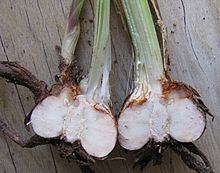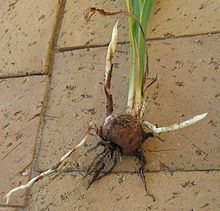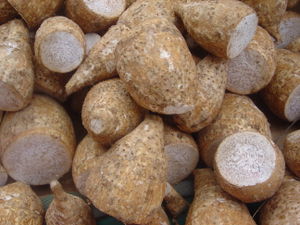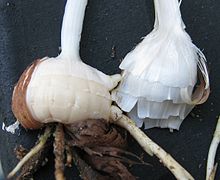- Corm
-
A corm (or bulbo-tuber, bulbotuber) is a short, vertical, swollen underground plant stem that serves as a storage organ used by some plants to survive winter or other adverse conditions such as summer drought and heat (estivation).
The word cormous is used to describe plants growing from corms, in analogy to the use of the terms "tuberous" and "bulbous" to describe plants growing from tubers and bulbs.[1]
Contents
Structure of a corm
 Crocosmia corm anatomy, showing tunic, cortex of storage tissue, central medulla, tunic, and emergence of a new corm from a bud near the top.
Crocosmia corm anatomy, showing tunic, cortex of storage tissue, central medulla, tunic, and emergence of a new corm from a bud near the top.
 Crosmia corm with stolons emerging through the tunic. The stolons originate at the axillary buds of the corm scales, and generally produce new corms at their tips
Crosmia corm with stolons emerging through the tunic. The stolons originate at the axillary buds of the corm scales, and generally produce new corms at their tips
A corm consists of one or more internodes with at least one growing point, with protective leaves modified into skins or tunics. The tunic of a corm is formed from dead petiole sheaths, remnants of leaves produced in previous years. They act as a covering, protecting the corm from insects, digging animals, flooding, and water loss. The tunics of some species are thin, dry, and papery, at least in young plants, however, in some families, such as Iridaceae, the tunic of a mature corm can be formidable protection. Many of the larger species of Watsonia for example, accumulate thick, rot-resistant tunics over the years; the product is a structure of tough, reticulated fibre. Other species, such as many in the genus Lapeirousia, have tunics of hard, woody layers.[2]
Internally a corm is mostly made of starch-containing parenchyma cells above a circular basal node that grows roots.
Long-lived cormous plants vary in their long-term development. Some regularly replace their older corms with a stack of younger corms, increased more or less seasonally. By splitting such a stack before the older corm generations wither too badly, the horticulturist can exploit the individual corms for propagation. Other species seldom do anything of that kind; their corms simply grow larger in most seasons. Yet others split when multiple buds on a large corm sprout independently, forming a tussock.
Corms can be dug up and used to propagate or redistribute the plant (see, for example, taro). Plants with corms can be propagated by cutting the corms into sections and replanting. Suitably treated, each section with a bud can generate a new corm.
Comparison of the corm and the bulb
Corms are sometimes confused with true bulbs; they are often similar in appearance to bulbs externally, and thus erroneously called bulbs. Corms are stems that are internally structured with solid tissues, which distinguishes them from bulbs, which are mostly made up of layered fleshy scales that are modified leaves. As a result, when a corm is cut in half it is solid, but when a true bulb is cut in half it is made up of layers.[3] Corms are structurally plant stems, with nodes and internodes with buds and produce adventitious roots. On the top of the corm, one or a few buds grow into shoots that produce normal leaves and flowers.
Cormels
Corms can form many small cormlets called cormels, from the basal areas of the new growing corms, especially when the main growing point is damaged. They are used to propagate corm forming plants. Corms of a number of species of plants are replaced every year by the plant with growth of a new corm; this process starts after the shoot has developed fully expanded leaves. The new corm forms at the shoot base just above the old corm. As the new corm is growing, short stolons are produced that end with the newly growing small cormels. As the plants grow and flower, the old corm is used up and shrivels away. The new corm that replaces the old corm grows in size, especially after flowering is done.
The old corm produces the greatest number of cormels when it is close to the soil surface. The small cormels normally take one or two more years of growth before they are large enough to flower.
Cormels do have a reproductive function, but in the wild they also are important as a survival strategy. In most countries where geophytes are common, so are animals that feed on them, whether from above like pigs, or from below like bulb weevils, mole rats or pocket gophers. Such animals make light of protective tunics, but they generally will miss several cormels that remain in the soil to replace the plant consumed. Plants such as Homerias, Watsonias and Gladioli, genera that are vulnerable to such animals, are probably the ones that produce cormels in the greatest numbers and most widely distributed over the plant. Homeria species produce bunches of cormels on underground stem nodes, and Watsonia meriana for example actually produces cormels profusely from under the bracts on the inflorescences.[4]
Roots
Many corms produce two different types of roots. Those growing from the bottom of the corm are normal fibrous roots, they are formed as the shoots grow, and are produced from the basal area at the bottom of the corm. The second type of roots are thicker layered roots that form as the new corms are growing, they are called contractile roots and they pull the corm deeper into the soil. In some species contractile roots are produced in response to fluctuating soil temperatures and light levels. In such species, once the corm is deep enough within the soil where the temperature is more uniform and there is no light, the contractile roots no longer grow and the corm is no longer pulled deeper into the soil. In some other species however, contractile roots seem to be a defence against digging animals and can bury the corm surprisingly deeply over the years. Wurmbea marginata[4] is one example of a small plant that can be challenging to dig unharmed out of a hard, clayey hillside.
Plants with corms
Cultivated plants that form corms include:
- Arisaema
- Bessera
- Bananas (Musa spp.)[5]
- Brodiaea
- Colchicum
- Crocosmia
- Crocuses, including the saffron crocus (Crocus spp.)
- Dichelostemma
- Dierama
- Eleocharis dulcis (Chinese water chestnut)
- Ensete spp. (enset)
- Freesia
- Gladiolus
- Some species of irises (Iris spp.)
- Konjac
- Liatris
- Milla
- Montbretia
- Pulaka
- Romulea
- Sagittaria spp. (arrowhead or wapatoo)
- Tecophilaea
- Taro (Colocasia esculenta, Alocasia macrorrhiza)
- Xanthosoma spp. (malanga, cocoyam, tannia, and other names)
See also
References
- ^ Pate, John; Dixon, Kingsley; Pate, J. S. (1982). Tuberous, Cormous and Bulbous Plants. Perth: University of Western Australia Press. ISBN 9780855642013.
- ^ Dyer, R. Allen, “The Genera of Southern African Flowering Plants”. ISBN 0 621 02854 1, 1975
- ^ "Bulbs and More - Bulb Basics". urbanext.illinois.edu. http://urbanext.illinois.edu/bulbs/bulbbasics.html. Retrieved 2009-12-25.
- ^ a b Manning, John (2008). Field Guide to Fynbos. Cape Town: Struik Publishers. ISBN 9781770072657.
- ^ http://www.efloras.org/florataxon.aspx?flora_id=1&taxon_id=121345
Categories:- Plant morphology
- Plant reproduction
Wikimedia Foundation. 2010.



